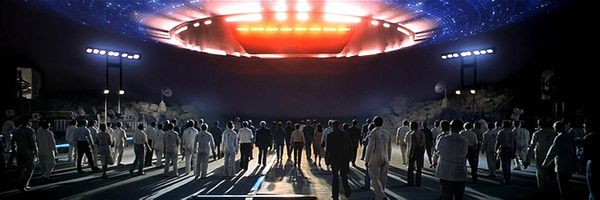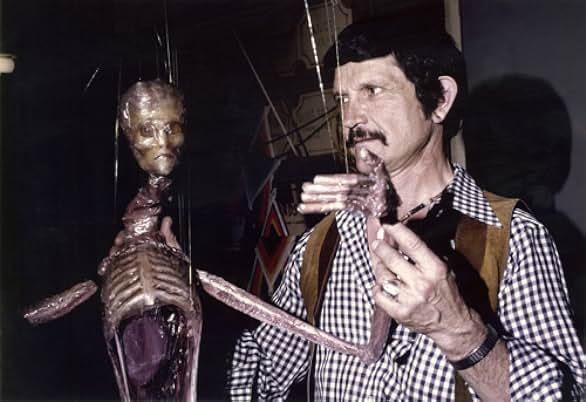Close Encounters of the Third Kind

 The central character, Roy Neary, is an ordinary electrical lineman living in Indiana. One night, while investigating a power outage, he experiences a close encounter with a UFO. This encounter leaves Roy with a profound obsession, manifesting as visions of a mysterious mountain-like shape. Roy’s fixation on this vision grows, straining his relationship with his wife, Ronnie, and their children.
The central character, Roy Neary, is an ordinary electrical lineman living in Indiana. One night, while investigating a power outage, he experiences a close encounter with a UFO. This encounter leaves Roy with a profound obsession, manifesting as visions of a mysterious mountain-like shape. Roy’s fixation on this vision grows, straining his relationship with his wife, Ronnie, and their children.
 Parallel to Roy’s story is that of Jillian Guiler, a single mother whose young son, Barry, is abducted by the extraterrestrials. Jillian also experiences visions of the same mountain shape and becomes determined to find her son and understand the significance of her visions. Roy and Jillian’s paths converge as they independently identify the mountain from their visions as Devils Tower in Wyoming. Driven by an irresistible urge, they travel to the site, evading a government cover-up operation aimed at keeping the public away from the area. The government has been secretly preparing for a potential encounter with extraterrestrials, using Devils Tower as the designated meeting place.
Parallel to Roy’s story is that of Jillian Guiler, a single mother whose young son, Barry, is abducted by the extraterrestrials. Jillian also experiences visions of the same mountain shape and becomes determined to find her son and understand the significance of her visions. Roy and Jillian’s paths converge as they independently identify the mountain from their visions as Devils Tower in Wyoming. Driven by an irresistible urge, they travel to the site, evading a government cover-up operation aimed at keeping the public away from the area. The government has been secretly preparing for a potential encounter with extraterrestrials, using Devils Tower as the designated meeting place.
 The film reaches its climax at Devils Tower, where Roy and Jillian witness the arrival of a massive mothership. In a breathtaking sequence, the government team communicates with the extraterrestrials using a series of musical tones, establishing a peaceful dialogue. The extraterrestrials return Barry to Jillian, and Roy is chosen to board the mothership, leaving Earth behind to embark on a journey with the aliens. The film concludes with the awe-inspiring departure of the mothership, leaving viewers with a sense of wonder and the possibility of peaceful coexistence with extraterrestrial beings. Roy’s journey represents humanity’s innate curiosity and longing to explore the unknown, reflecting Spielberg’s optimistic view of human-alien interaction.
The film reaches its climax at Devils Tower, where Roy and Jillian witness the arrival of a massive mothership. In a breathtaking sequence, the government team communicates with the extraterrestrials using a series of musical tones, establishing a peaceful dialogue. The extraterrestrials return Barry to Jillian, and Roy is chosen to board the mothership, leaving Earth behind to embark on a journey with the aliens. The film concludes with the awe-inspiring departure of the mothership, leaving viewers with a sense of wonder and the possibility of peaceful coexistence with extraterrestrial beings. Roy’s journey represents humanity’s innate curiosity and longing to explore the unknown, reflecting Spielberg’s optimistic view of human-alien interaction.
 “Close Encounters of the Third Kind” explores themes of obsession, communication, and the quest for understanding. Spielberg’s film stands out for its humanistic approach to the alien encounter genre, portraying the extraterrestrials as benevolent beings rather than threats. The use of music as a universal language highlights the potential for harmony and mutual respect between different species. The film’s innovative special effects, created by Douglas Trumbull and his team, were groundbreaking at the time and earned an Academy Award. The visual representation of the UFOs and the mothership has become iconic in cinematic history. John Williams’ memorable score, especially the five-note motif used for communication with the aliens, is a significant element of the film’s enduring legacy.
“Close Encounters of the Third Kind” explores themes of obsession, communication, and the quest for understanding. Spielberg’s film stands out for its humanistic approach to the alien encounter genre, portraying the extraterrestrials as benevolent beings rather than threats. The use of music as a universal language highlights the potential for harmony and mutual respect between different species. The film’s innovative special effects, created by Douglas Trumbull and his team, were groundbreaking at the time and earned an Academy Award. The visual representation of the UFOs and the mothership has become iconic in cinematic history. John Williams’ memorable score, especially the five-note motif used for communication with the aliens, is a significant element of the film’s enduring legacy.
 “Close Encounters of the Third Kind” has left a lasting impact on both science fiction and popular culture, influencing numerous films and inspiring a sense of wonder about the possibility of life beyond Earth. Spielberg’s masterful storytelling, combined with the film’s technical achievements, make it a timeless classic that continues to captivate audiences with its imaginative and hopeful vision of first contact.
“Close Encounters of the Third Kind” has left a lasting impact on both science fiction and popular culture, influencing numerous films and inspiring a sense of wonder about the possibility of life beyond Earth. Spielberg’s masterful storytelling, combined with the film’s technical achievements, make it a timeless classic that continues to captivate audiences with its imaginative and hopeful vision of first contact.